8.Heredity
Sakshi Education
Heredity – From Parent to Progeny

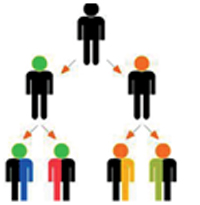
Synopsis:
- Variations are quite apparent among closely related group of organisms.
- In about 1857, Gregor Johann Mendel started working on the problem of how variations are passed from one generation to another.
- Mendel had chosen pea plants consisting of 7 distinguishing forms: flower colour, position, seed colour, shape, pod colour, pod shape and stem length.
- In F1 generation all pea seeds were yellow.
- In F2 generation about 75% seeds were yellow and about 25% seeds were green. This is called phenotype. The ratio is 3:1.
- In F2 generation out of 75%, 25% seeds were pure yellow seeds, 50% were yellow seeds but green as a recessive factor. Remaining 25% were pure green. This is called genotype. The ratio is 1:2:1.
- In F3 generation, Mendel self pollinated F2 generation pea plants and found that a set of peas about 25% gave only yellow seed giving pea plants, rest of the yellow pea plants gave about 75% yellow and about 25% green seed giving pea plants, and the set of green peas gave only green seed giving pea plants.
- Every pea plant has two “factors” which are responsible for producing a particular property or trait called “allele”.
- During reproduction one ‘factor’ from each parent is taken to form a new pair in the off spring.
- One of these will always dominate the other if mixed together.
- Crossing yellow and green seeds produced all yellow seeds. Because yellow is the dominant factor.
- In the inheritance of more than one pair of characters, the factors for each pair of characters assorts independently of the other pairs. This is known as “law of independent assortments”.
- The factors which are responsible for character or trait of an organism, are named as ‘genes’.
- Law of dominance states that, among a pair of alleles for a character, only one expresses itself in the first generation, as one of the allele is dominant over the other.
- Law of segregation states that every individual possesses a pair of alleles for any particular trait and that each parent passes a randomly selected copy (allele) of only one of these to its offspring.
- Those characters which pass from parents to children or from one generation to next generations are called “Inherited traits” or “Inherited characters”.
- The process of inheriting characters or traits from parents is called “Heredity”.
- The process in which traits are passed from one generation to another is called “Inheritance”.
- Each human cell contains 23 pairs of chromosomes. Out of these, 22 pairs are called autosomes and one pair is called allosomes.
- Females have two X chromosomes in their cells, so all the gametes produced by woman will be with only X chromosomes.
- Males have one ‘X’ and one ‘Y’ chromosomes in their cells, so the gametes produced by man will be of two types, one with ‘X’ chromosomes and the other with ‘Y’ chromosomes.
- If the sperm carries X chromosome and fertilizes the ovum (X chromosome), the resultant baby will have XX condition. So the baby will be a girl.
- If the sperm carries Y chromosome and fertilizes the ovum (X chromosome), the resultant baby will have XY condition. So the baby will be a boy.
- Each species tends to produce a large number of offsprings, but only the fittest will survive.
- The organisms with useful traits will survive. If traits are not useful to organisms, then they are going to be perished or eliminated from the environment. This is nothing but natural selection.
- Sometimes, accidents change the frequency of genes in small populations, this one is known as ‘generic drift’.
- Lamarck proposed that the acquired characters are passed to its offspring to its next generation.
- Charles Darwin proposed the theory of “Natural Selection”.
- Small changes within the species is known as “Micro Evolution”.
- The process of formation of new species is known as speciation or macro evolution.
- If the organisms of the same species with some variations are separated by some cause for long years, there may be a lot of variations taking place in these years. Even though they meet accidentally, they cannot mate and produce new offsprings. Thus new species has been formed.
- Homologous, analogous organs and embryological evidences explain evolutionary relationships.
- Some traits in different organisms would be similar because they are inherited from a common ancestor.
- If we observe the anatomy of forelimbs of a whale, bat, horse, mole and man, all the animals have a common pattern in the arrangement of bones. It indicates that all the vertebrates have evolved from a common ancestor. These organs are called homologous organs. This type of evolution is called ‘Divergent evolution’.
- If we observe the wings of birds and bats, they look similar because they have common use for flying, but their origins are not common. These organs which are structurally different but functionally similar are known as “Analogous Organs”. This type of evolution is called “Convergent Evolution”.
- These are remarkable similarities in the embryos of different animals from fish to man, especially at an early stage. This exhibits the structural features of their common ancestor. This is called Embryological Evidence.
- Fossils are the evidence of ancient life forms or habitats which have been preserved by the natural processes.
- Human evolution is the evolutionary process leading up to the appearances of modern human being.
4 Marks Questions and Answers
- What are variations? How do they help organisms?
Ans.- Differences in characters within very closely related groups of organisms are referred to as variations.
- Variations develop during reproduction in organisms.
- Sexual reproduction and errors in DNA copying through heredity.
- Variations are passed from parent to offspring through heredity.
- Thus the variations accumulate over the generations.
- Beneficial variations are selected by the nature in evolution.
- These variations increase survival chance of the organisms.
- These variations help the organisms to adapt to their environment.
- Accumulated variations gradually lead to evolution.
- In a mango garden a farmer saw one mango tree with full of mango fruits but with a lot pests. He also saw another mango tree without pests but with few mangoes. But the farmer wants the mango tree with full of mango fruits and pest free. Is it possible to create new mango tree which the farmer wants? Can you explain how it is possible?
Ans:- Yes, it is possible to create a new mango tree which the farmer wants.
- This can be achieved by the law of independent assortment with dihybrid inheritance.
- Two pairs of contrasting characteristics (high pests and low yield no pests) are involved in dihybrid inheritance.
- In this process, we have to cross the high yield and high pest plant with low yield, no pest plant. In F1 generation, we get all high yield and full of pest plants.
- In F2 generation, mango trees having yield and full of pests would cross bred by self pollination, then high yield and no pest combination plants would be achieved. The phenotype ratio in dihybride cross = 9:3:3:1. This is also called dihybreed ratio.
- Though the two pairs of original characteristics combine in F1 generation but they separate and behave independently in subsequent generations.
- What is Law of Independent Assortment? Explain with example?
Ans:- In the inheritance of plants more than one pair of traits in cross simultaneously, the factors responsible for each pair of traits are distributed independently to the gametes.
- This can be explained by taking pea plants with two contrasting characters.
- Colour of peas – yellow and grey symbolically indicated as Yy .
- Shape of peas – round and wrinkled symbolically indicated as ‘R’ ‘r’.
- The plants with yellow and round seeds (pure) were crossed with those having green and wrinkled seeds. (pure).
- All pea seeds that were yellow and round skin. Each pea will have factors ‘Yy Rr’.
- Since yellow colour (Y factor) and round skin (R factor) are dominant traits. All the pea seeds will be round and yellow (F1 generation).
- In F2 generation some seeds were round and yellow (Yy Rr or YYRR) some were round and green (yy RR yy Rr), some seeds were wrinkled and yellow (Yy rr or Yy rr) and some seeds were wrinkled and green (yyrr).
- How sex determination takes place in humans? Explain with example.
Ans:- Each human cell contains 23 pairs (46) chromosomes. Out of 23 pairs, 22 pairs of chromosomes are called sex chromosomes or allosomes.
- There are two types of chromosomes namely ‘X’ and ‘Y’ which determine the sex of an individual.
- Female have two ‘X’ chromosomes in their cells (XX). Males have one ‘X’ and one ‘Y’ chromosomes in their cells (XY).
- All the gametes (sperms) produced by man are of two types - X chromosome and other Y chromosome. If the sperm carries Y chromosome and fertilizes the ovum (X chromosome), the baby will have XY condition. So, the baby will be a boy.
- If the sperm carries X chromosome and fertilizes the ovum (X chromosome). The baby will have XX condition. So the baby will be a boy.
- This can be represented as follows.
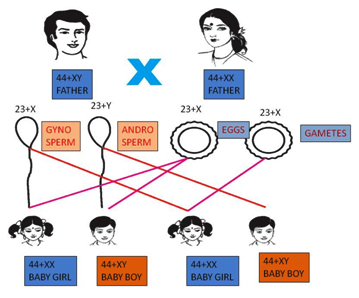
- Explain the Darwin’s Theory ‘Natural Selection’ with an example.
Ans:- Any group of population of an organism develops variations and all members of group are not identical.
- Variations are passed from parent to offspring through heredity.
- The natural selection over abundance of offspring leads to constant struggle for their survival in any population.
- Individuals with variations that help them to survive and reproduce tend to live longer and have more offsprings than organisms with less useful features.
- The offsprings of survivors inherit the useful variations and the same process happens with every new generation until the variation becomes a common feature.
- As the environment changes, the organism within the environment adapt and changes to the new living conditions.
- Over a long period of time, each species of organism can accumulate so many changes that it becomes a new species, similar to but distinctly different from the original species. All species on the earth arise in this way.
-
Evolution is a slow and continuous process.
- There are some limitations and objections to the Darwin’s Theory. Many new theories like Synthetic Theory, Mutation Theory are put forward.
Natural Selection:The concept of ‘Natural selection’ can be explained with the following example.- There will be some variations in the animals because they are produced by sexual reproduction.
- In one of the progeny, may be tall having long legs than other progeny. There may variation of height in the progeny.
- When there is no food is available on the land, then the progeny having long legs can reach the leaves of tall trees, eat them as food and survive.
- The progeny which has short height due to short legs cannot reach the leaves on the tall trees, they will not get food they will starve and hence die.
- Thus, nature has selected the animal with long legs to survive.
-
Since, long legs help in survival, the long legged animals will live long enough to produce their offsprings. The offsprings will inherit long legs. So, all the future generations will have long legged animals.
-
With the help of give information write your comment on evidence of evolution. Mammals have four limbs as do birds, reptiles and amphibians. The basic structure of the limbs is similar, though it has modified to perform different functions.
Ans:- The organs which have the same basic structure but different functions are called homologous organs.
- The homologous organs of different animals provide evidence for evolution.
- I feel wonder to know that internal structure of forelimb of a whale (swimmer), wing of a bat (flyer) the leg leopard (runner), claw of mole (digger) and hand of a man (grasping).
- If we carefully observe the anatomy of all these animals have a common pattern in the arrangement of bones, even through their external from and functions are different.
- It indicates that all the vertebrates have evolved from a common ancestor and these organs are called homologous organs. This type of evolution is called divergent evolution.
- Collect information about carbon dating method. Discuss with your physical science teacher.
Ans:- Study of fossils is called ‘Paleontology’.
- Paleontologists determine the age of fossil by using ‘Carbon dating Method’.
- Fossils which we find today were once living objects. All the living objects contain some carbon 14 atoms which are radioactive.
- When a living object dies and forms fossil, its carbon 14 radioactivity goes on decreasing gradually.
- In the carbon dating method, the age of fossils is found by comparing the Carbon – 14 radio activity left in fossils with Carbon – 14 radio activity present in living objects today.
- Write a monologue on evolution of man to perform a stage show on the theatre day in your school.
Ans : I am the modern man. But, you don’t know my ancient history. I would like to give you my evolutionary process leading up to this modern appearance.
Early man like forms appeared about 7.50 lakh thousand years ago. The scientific name my species is ‘Homo sapiens’. My true appearance came on to the earth 2 lakh 50 thousand years ago. My ancestral forms like Homo-habilus lived between 1.6 to 2.5 million years ago. Homo-erectus lived between 1-1.8 million year ago. Homosapiens neanderthalensis lived between 2,30,000 – 3,00,000 thousands years ago.
My species (Homo-sapiens) appeared about 40,000 years ago.
There is a great diversity of my forms and features across the planet. But I want peace and all the separated by the domestic walls like racism and terrorism. But I want peace and all the people of the world are nothing but brothers. I want them to live in peace and harmony. Friends ! I think you wondered about my ancient evolutionary history, have a nice day – Thank you.
- How do you perform the activity in which you can list out the inherited traits from your family members?
Ans:Characters
In me
In my mother / Father
In my grandma/Grandpa
Note: Students will fill this table and will answer the questions give below.
- Is there any character in you similar to that of your mother as well as your grandma
- Is there any character in you similar only to that of your grandma?
- How do you think these characters may have been inherited by you from grandma
- Is there any character that is not present in grandma but present in your mother and you?
- Think where from your mother got that character?
- How do you conduct a survey among your classmates on inherited characters?
Ans:
Note: Students will fill this table basing on the collected data and will answer the questions.Name of your friend
Colour of skin
Ear lobes Free/attached
Marking on inner side of thumb
Length of forehead
Colour of eyes(Cornea)
Any other features
- Compare your characters to that of any one of your friend. How many characters did you find were similar among you and your friend?
- Do you share more similar characters with your parents or with your friends?
- Do you think that your differences from parents are same as differences from friends? Why/Why not? Differences in characters with very closely related groups of organisms are referred to as variations. Often a new character in a group may lead to variations that are also inherited.
- Is variation all about apparent differences?
- Create an activity to understand the Mendelian Principles of Heredity.
Ans: Materials required:
a) 3cm length and 1 cm breadth chart pieces – 16
b) 2 cm length and 1 cm breadth chart pieces – 16
c) Red buttons -16
d) White buttons – 16
e) Chart, scale, sketch pen, pencil, 2 bags.
Method:
Prepare a chart with 4 X 4 boxes along with number and symbol as shown in the figure.
Game – 1: Monohybrid cross (starting with hybrid parents)
To start with take 1, 2 or 3, 4. In case you start 1, 2 pick all the 16 long and short pieces and prepare such pairs in each of which you have a long and short piece.
Take 8 pairs each of long and short strips and put them in two separate bags. Now each bag contains 16 strips (8 long and short). One bag say ‘A’ represents male and the ‘B’ represents female. Now randomly pick one strip each from bag A and B and put them together in the 1 on the chart. Keep picking out the strips and arrange them in the same manner till your bags are empty. Same time your boxes in the chart are filled with pairs of strips. You might have got the following combinations, two long strips, one long and one short strip, two short strips.
- In a forest there are two types of deers, in which one type of deer can run very fast and the second one cannot run as fast as the first one. Lions, Tigers hunt deers for their food. Imagine which type of deers population is going to be eliminated and why?
Ans:- The deers that can run fast can survive in the forest.
- The slow running deers will become prey for the predators and soon they are going to be eliminated.
- It is because, nature favours only useful variations. Each species tend to produce large number of offspring. They compete with each other for food, space, and mating purposes. It is the struggle for existence. Only the fittest can survive. Here, ‘fast running’ is the useful variation in the deers. So, these deer can escape from the tigers and lions in the forest and their population have gradually increased. On the other hand, the slow running deers have become pray for the tigers and lions and lions and they gradually got eliminated from the forest. This is nothing but, ‘natural selection’.
- One student (researcher) wants to cross pure tall plant (TT) with pure dwarf (tt) plant, what would be the F1 and F2 generations? Explain.
Ans:- The gametes of pure tall plant (TT) then cross with the pure dwarf plant (tt) by the process of fertilization to from zygotes which then produce various progeny in F1 generation which consists all tall plants.
- Thus, in the F1 generation, all the progeny plants have factors (Tt) in which T is the factor for tallness, which is a dominant triat. Since, all the plants in F1 generation have the factors (Tt), so all of them are tall.
- The small letter ‘t’ represents recessive trait of dwarfness which does not show up in the first generation in the presence of dominant trait ‘T’.
- When two hybrid tall plants (Tt) produced in the F2 generation are now cross – breed with each other, then they will produce second generation (F2) plants.
- The plants produced have genotype T T, tT, Tt and tt.
- The plants having genotype T T, Tt and tT all contains the factor T for dominant trait ‘tallness’, so all these three plants are tall.
- The plant having genotype ‘tt’ has both factors‘t’ for the recessive trait ‘dwarfness’, so it is a dwarf plant.
- So, in the F2 generation, the genotypic ration in monohybrid cross will be T T : Tt : tt = 1:2:1 The phenotypic ratio in mono hybrid cross will be: Tall plants: Dwarf plants = 3:1
- Thus, the researcher would obtain the above results in his experiment. Monohybrid Cross

- Explain monohybrid experiment with an example, which law of inheritance can we understand? Explain.
Ans: According to Mendel’s law of inheritance, the characteristics of an organism are determined by internal ‘factors’ which occur in pairs. Only one of the pair of such factors can be present in a single gamete.- The gametes of pure tall plant (T T) then cross with the pure dwarf plant (tt), by the process of fertilization to from zygotes which then produce various progeny in F1 generation which consists of all tall plants.
- Thus, in the F1 generation, all the progeny in plants have factors (Tt) in which T is the factor for tallness, which is a dominant trait. Since, all the plants in F1 generation have the factors (Tt), so all of them are tall.
- The small letter‘t’ represents recessive trait of dwarfness, which does not show up in the first generation in the presence of dominant trait ‘T’.
- When two hybrid tall plants (Tt) produced in the F1 generation are now cross – breed with each other, then they will produce second generation (F2) plants.
- The plants produced have genotype T T, tT, Tt, and tt.
- The plants having genotype T T , , Tt and tT all contains the factor T for dominant trait ‘tallness’, so all these three plants are tall.
- The plant having genotype ‘tt’ has both factors ‘t’ for the recessive trait ‘dwarfness’, so it is a dwarf plant.
- So, in the F2 generation, the genotypic ration in monohybrid cross will be TT : Tt : tt = 1:2:1 The phenotypic ratio in monohybrid cross will be Tall plants: Dwarf plants = 3:1
- Thus, the researcher would obtain the above results in his experiment.
- What are variations? Explain with a suitable example.
Ans:- The difference in the characters among the individuals of species is called variations.
- Variations develop during reproduction in organisms. Sexual reproduction and errors in DNA copying leads to variations in offsprings in a population.
- This can be explained in beetle populations.
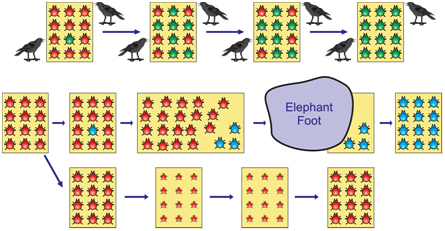
Variations in beetle population
Observe the below diagram showing variation in beetle population and it its impact.
Let us consider a group of twelve beetles. They live in bushes on green leaves. Their population will grow by sexual reproduction. So they were able to generate variations in population. Let us assume crows eat these red beetles. If the crows eat more Red beetles their population slowly reduced.
Situation – 1:
In this situation a colour variation arises during reproduction so that there appears one beetle that is green in colour instead of red. Moreover, this green-coloured beetle passes it’s colour to its offspring (Progeny). So that aii its progeny are green. Crows cannot see the green-coloured beetles on green leaves of the bushes and therefore crows cannot eat them. But crows can see the red beetles and eat them. As a result there are more and more green beetles than red ones which decrease in their number.
The variation of colour in beetle ‘green’ gave a survival advantage to ‘green beetles’ than red beetles. In other words it was naturally selected. We can see that the ‘natural selection’ was exerted by the crows. The more crows there are, the more red beetles would be eaten and the more number of green beetles in population would be. Thus the natural selection is directing evolution in the beetle population. It results in adaptation in the beetle population to fit in their environment better.
- In what way Mendel used the word ‘Traits’ – explain with an example.
Ans:- Mendel hypothesized that characters were carried as traits and an organism always carried a pair of factors for a character.
- He also hypothesized that distinguishing traits of the same character were present in the population of an organism.
- He also assumed that the traits shown by the pea plants must be in the seeds that produced them. The seeds must have obtained these traits from the parent plants.
- Mendel crossed the pure bred ‘dwarf’ pea plants with pure-breed fall pea plants.
In F1 generation no dwarf pea plants were obtained in the first generation of progeny. That means the first generation showed the traits of only one of the parent plants tallness. The trait of ‘dwarfness’ did’t show up in the progeny.
Then Mendel crossed the F1 generation plants and obtained three tall plants and one dwarf plant. The dwarf trait of the parent plant which had seemingly disappeared in the first generation progeny, reappeared in the second generation. Mendel named this trait as ‘recessive trait’ and the expressed trait of tallness as ‘dominant’.
- Draw a checker board show the law of independent assortment with a flow chart and explain the ratio.
Ans: Mendel’s law of independent assortment:
Till now have discussed about the Mendel’s hypothesis with monohybrid cross. Mendel’s also tried to understand the inheritance of two pairs of characters together. In this dihybrid cross, parents produce offsprings containing the factors for characters (traits) of yellow (YY), Round(RR) and wrinkled (rr), green (yy). These characters appeared independently without mixing with each other in F2 generation, which were produced by self pollination in F1 generation.
Observe the checker board given here carefully and note down different combinations of characters resulted from dihybrid cross.
1) RRYY 2) RRYy 3)Rr YY 4) Rr YY 5) RRYy 6) Rr YY 7) Rr Yy 8) Rr Yy 9) RrYy are having Round and yellow seeds.
1) RRyy 2) Rryy have Round and Green seeds
1) Rryy 2) rrYy 3) rr Yy have Wrinkled and Yellow seeds
1) rryy have Wrinkled and Green seeds
From the above results it can be concluded that the factors for each character of trait remain independent and maintain their identity in the gametes. The factors are independent to each other and passes to the offsprings (through gametes).
In the inheritance of more than one pair of characters (traits), the factors for each pair of characters assorted independently of the other pair. This is known as “Law of independent assortment”.
Mendel believed that every character or trait is controlled or responsible by a pair of factors.
The factors which are responsible for a character or trait of an organism now named as ‘genes’. The pair of genes which are responsible for a character are called as ‘alleles’. Alleles are of two types one is homozygous type (YY or TT) and the other is heterozygous (Yy or Tt).
- Explain the process to understand monohybrid cross of Mendel experiment with a checker board.
Ans:- Cross pollination of yellow and green gave, all pea seeds were yellow in F1 generation.
y
Y
Y
Yy
Yy
Y
Yy
Yy
Yy……….(yellow)- In the second filial generation (or) F2 generation about 75% yellow (seeds) peas and about 25% green (seeds) peas. On self pollinating the F1 generation peas, the new breed have combination of Y and y.
Y
y
Y
YY
Yy
y
Yy
yy
YY……….(yellow) yy…….(Green) The breed after cross pollination will have one factor from pure breed yellow (Y) and one from the pure breed green (y). That is all the peas will have paired factor ‘Yy’ abd the peas will be yellow as ‘Y’ factor is ‘dominant’. Any pea that has ‘yy’ factor will be green. All the combinations are equal.
- YY will be 25% (yellow)
- yY will be 25% (yellow)
- Yy will be 25% (yellow)
- yy will be 25% (Green)'
- Prepare a chart showing evolution of man through ages.
- Cross pollination of yellow and green gave, all pea seeds were yellow in F1 generation.
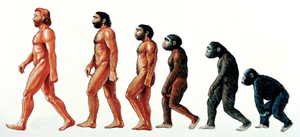
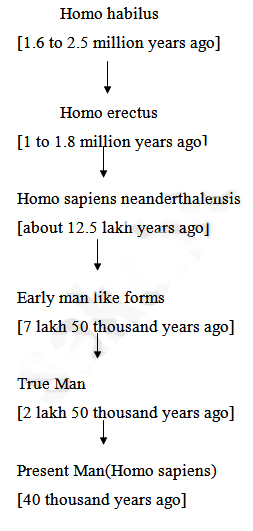 2Marks Questions and Answers
2Marks Questions and Answers
- what are variations? How do they help organism?
Ans:- Differences in characters with in very closely related group of organisms are referred to as variations.
- Often a new character in a group may lead to variations that are inherited.
- The variation is a necessity for organic evolution.
- The great advantage of variation to species is that it increases the chances of it survival in a changing environment.
- One experimenter cut the tails of parent, what could be the traits in offspring’s ? Do the daughter rats contain tails or not? Explain your argument.
Ans:- The daughter rats would have tails with them.
- Actually, the cut tail of rats is an acquired trait which is never passed on to their progeny.
-
This is because cutting the tails of rats does not change the genes of their reproductive cells.
- What variations generally have you observed in the species of cow?
Ans: We can observe the following variations in the species of cow.
a) The variation in colour
b) The variation in horns
c). The variation in height
d) The variation in legs
e) The variation in hooves
f) The variation in tail etc. - What are the characters Mendel selected for his experiments on pea plant?
Ans: Mendel has selected the followings contrasting characters in pea plant.- Flower colour (Purple – White)
- Flower position (Axial – Terminal)
- . Seed colour (Yellow – Green)
- Seed shape (Round – Wrinkled)
- Pod shape (Inflated – Constricted)
- Pod colour (Green – Yellow)
- Stem length (Tall – Dwarf)
- How do scientists utilize the information about fossils?
Ans:- The remains of dead animals or plants that lived in the remote past are know as fossils.
- Fossils provide evidence for evolution. For example a fossil bird called ‘Archaeopteryx’ looks like a bird, but it has many other features which are found in reptiles.
- Archaeopteryx has feathered wings like those of birds but teeth and tail like those if reptiles. So, Archaeopteryx is called ‘Connecting link’ between reptiles and birds.
- It suggests that birds have evolved from the reptiles.
- Thus, fossil provide the evidence that the present animals have originated from the previously existing ones through the process of continuous evolution.
-
Mendel selected a pea plant for this experiment. Mention the reasons in your point of view?
Ans:- Mendel chose pea plants for studying inheritance because pea plants had a number of clear cut differences which well easy to tell apart.
- Another reason for choosing pea plants was that were self pollinating which enabled them to produce next generation of plants easily.
- Mendel has chose pea plants to study inheritance because many generation of pea plants can be produced in a comparatively short time span and their study is much simpler than that of animals.
-
If the theory of inheritance of acquired characters proposed by Lamark was true how will the world be?
Ans:- All the acquired characters of the parental generation will be carry forwarded to the next progeny. But it is not actually happening. If it occurs, then all the swimmer’s sons will become swimmers, doctor’s son’s will become doctors.
- Pilots, Lawyer, Linguists, Singers, Musicians etc., all will carry their acquired traits to their progeny and their progeny will also become the same just like their parents.
- The process of continuous evolution may be disturbed.
-
What is your understanding about survival of the fittest. Give some situations or examples that you observe in your surroundings?
Ans:- When a cat chasing two rats, the rat which can run fast will survive and the slower one will be caught and killed. Here, ‘the survival of the fittest’ is the speedily running rat, which escapes from the hungry cat.
- When two or more dogs came to eat the remains of food material, the strongest dog would threaten and also fight for the food. The weaker dogs stood away from food until this strongest dog finished his meal. Here, the ‘strongest dog’ is the survival of fittest which got its food.
- Observe seeds in pea or bean pod and answer the following questions.
a) Can you find two similar seeds there?
b) What makes them vary?
c) Why variations are important? How are organisms useful for an organism or population?
Ans: a) Yes, I could not found two similar seeds.
a) It is because of variations in the genetic material.
b) Variations are useful to survive in the changing environment. They leads to the formation of new species and they are tools of continuous process of evolution.
-
Male is responsible for sex determination of baby – do you agree? If so write your answer with a Flow chart.
Ans: Yes, I agree with the statement. This can be shown with the help of the following flow chart.
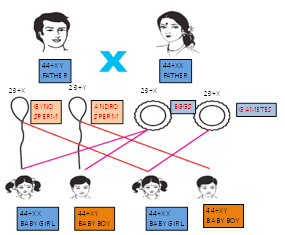
- What differences Mendel identified between parent and F2 generation?
Ans.PARENT
F2 GENERATION
- They are pure breeds
- They consist of mixed population
- They consist of homozygous alleles.
2.They consists of homozygous alleles in some plants and heterozygous alleles in some other plants.
- They have some fixed characteristic features.
3.New combination of characters will appear.
One Mark Questions and Answers
- What are variations?
Ans. Differences in characters within very closely related groups of organisms are referred to as “variations”.
- What are genes?
Ans. Genes are the factors which are responsible for character or trait of an organism. These are units of heredity that is transferred from parent to offspring. These are the segments of nucleic acid ‘DNA’ which is present in the nucleus of every cell.
- What is allele?
Ans. The part of the genes which are responsible for character is called “allele”.
- What are homozygous alleles?
Ans. Homozygous alleles are the same alleles. Either both dominant or both recessive. Ex. TT,tt
- What is a heterozygous allele?
Ans. Heterozygous allele is that which has both dominant gene and recessive gene. Ex. Tt
- What is heredity?
Ans. The process of acquiring characters or traits from parents is called “Heredity”.
- What is inheritance?
Ans. The process in which traits are passed from one generation to another generation is called “inheritance”.
- What are allosomes?
Ans. Sex determining chromosomes are called ‘allosomes’. Or ‘sex chromosomes’. In humans there is a pair of allosomes. There are two types of allosomes in humans, namely X and Y.
- What are autosomes?
Ans. Chromosomes whose number and morphology do not differ between males and females of a species are called ‘autosomes’. - What are homologous organs?
Ans. Organs which have a common fundamental anatomical plan and similar embryonic origin whatever varied functions they may perform are called “homologous organs”.
Ex:- Flippers of a whale, wing of a bat and
- Forelimb of a horse and forelimb of human.
- What are analogous organs?
Ans. Analogous organs are those that perform similar function s but have entirely different embryonic origins.
Ex: Wing of a bird and wing of a bat.
- What is a micro evolution?
Ans. The process of small changes taking place within the species is known as ‘micro evolution’.
- What is a macro evolution or speciation?
Ans. The process of evolution through which new species are going to be formed is known as ‘speciation’ or ‘macro evolution’.
- What are fossils?
Ans. Fossils are of ancient life forms or ancient habitats which have been preserved by natural process.
- What are vestigial organs?
Ans. Organs which are not useful in animals are called ‘vestigial organs’.
Published date : 09 Nov 2023 11:49AM
Tags
- AP 10th
- AP 10th Study Material
- AP 10th Biology
- Tenth Class Heredity Study Material
- Heredity
- Tenth Class Biology Study Material
- 10th Class Biology Study Material
- Heredity
- sakshi education study materials
- ap10th class study materials
- ap10th class biology study materials
- 10th class biology study materials












